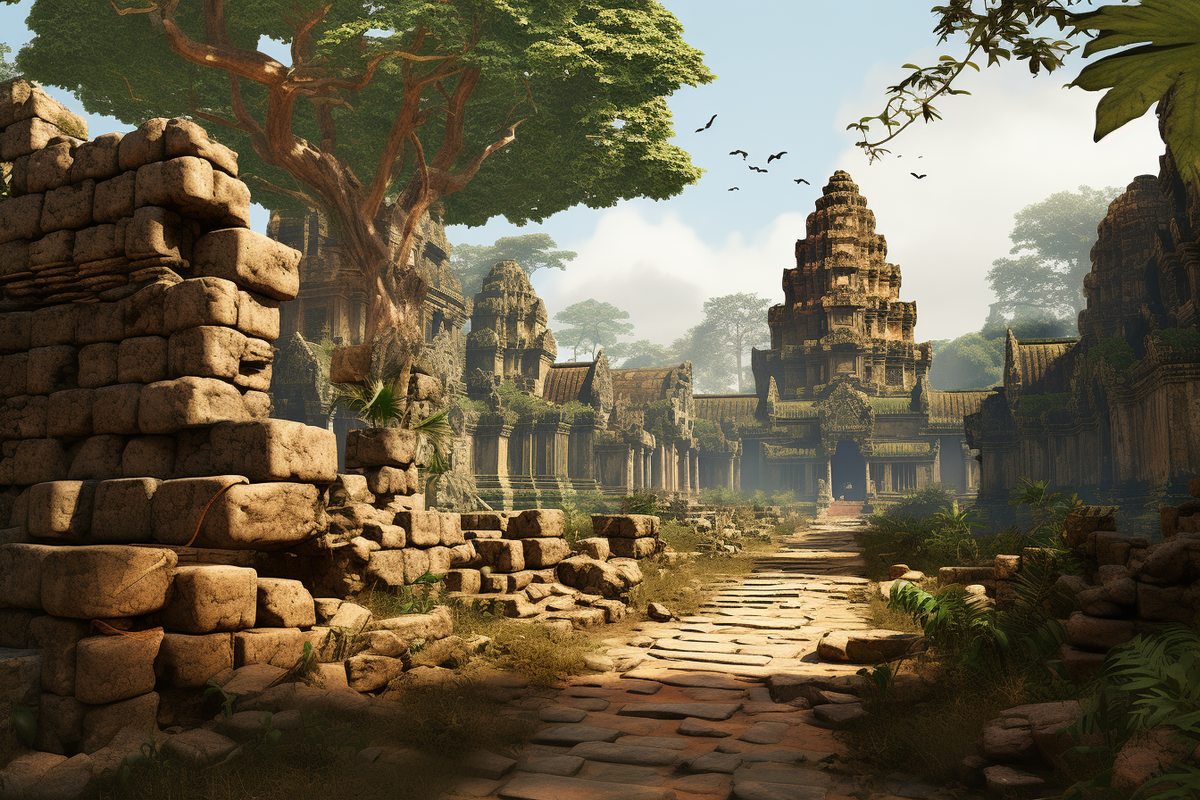A Timeline of Cambodia
A broad timeline of Cambodia.

Early Hunter-Gatherers (circa 5000 BC - 3000 BC)
Archaeological evidence suggests that the region now known as Cambodia was inhabited by hunter-gatherer communities. These early inhabitants relied on the abundant natural resources, including fish from the Mekong River and Tonlé Sap Lake, as well as forest game.
Neolithic Transition (circa 3000 BC - 2000 BC)
The shift from hunting-gathering to agriculture began around this time. Early Cambodians started to settle in villages, cultivating rice and domesticating animals. Pottery and simple tools from this period have been found, indicating a more settled lifestyle.
Bronze Age and Iron Age (circa 2000 BC - 1st Century AD)
The introduction of metal tools marked the transition to the Bronze Age. This was followed by the Iron Age, where more advanced agricultural techniques were developed. Settlements grew in size and complexity, laying the foundation for the organised political entities that would follow.
Rise of the Funan Kingdom (circa 1st Century - 6th Century AD)
The Funan Kingdom emerged in the Mekong Delta region. It is considered the first organised political entity in Cambodia. The kingdom was a significant maritime power, engaging in trade with India and China. Indian influence was strong, evident in the adoption of Hinduism and the Sanskrit language. The Funan Kingdom was known for its complex irrigation systems, which supported rice cultivation.
Transition to the Chenla Kingdom (circa 6th Century - 8th Century AD)
By the 6th century, the Funan Kingdom was succeeded by the Chenla Kingdom. Unlike Funan, which was a loose collection of chiefdoms, Chenla was a more centralised state. The kingdom expanded its territory inland and continued to be influenced by Indian culture, particularly Hinduism and Buddhism. Chenla was known for its impressive temples, some of which predate the famous Angkor Wat.
Fragmentation and Rise of Regional Powers (circa 8th Century - 802 AD)
The late 8th century saw the fragmentation of the Chenla Kingdom into Land Chenla and Water Chenla, each with its own line of kings. This period of division set the stage for the rise of the Angkor Empire. Despite internal strife, the influence of Indian culture and religion persisted, laying the groundwork for the grandeur of the Angkor period that would follow.
Foundation and Early Expansion (802 AD - 900 AD)
King Jayavarman II declared independence from Java and founded the Angkor Empire in 802 AD. He established the capital at Hariharalaya, near present-day Roluos. The early years were marked by territorial consolidation and the establishment of Hinduism as the state religion.
Golden Age under Suryavarman I and II (900 AD - 1150 AD)
The empire reached its zenith under the rule of Suryavarman I and Suryavarman II. Suryavarman II is best known for the construction of Angkor Wat, dedicated to the Hindu god Vishnu. This period saw the empire's territorial expansion into present-day Thailand, Laos, and Vietnam.
Introduction of Buddhism and Cultural Flourishing (1150 AD - 1300 AD)
Under King Jayavarman VII, Mahayana Buddhism became the state religion. He is known for constructing the Bayon Temple, famous for its massive stone faces. This period also saw the construction of Ta Prohm and Preah Khan, as well as the development of intricate water management systems.
Decline and External Threats (1300 AD - 1400 AD)
The empire began to decline due to internal strife, including religious conflict between Hindus and Buddhists. External invasions, particularly from the Ayutthaya Kingdom of Thailand, weakened the empire. The capital was moved several times in attempts to evade these threats.
Fall of Angkor and Aftermath (1400 AD - 1431 AD)
By the early 15th century, the empire was a shadow of its former self. In 1431, Angkor was sacked by the Ayutthaya Kingdom, marking the end of the Angkor Empire. The capital was moved to Phnom Penh, and the empire fragmented into smaller states, eventually becoming a vassal to more powerful neighbours.
Immediate Aftermath and Territorial Losses (1431 AD - 1600 AD)
Following the fall of Angkor, the capital was moved to Phnom Penh. The kingdom faced a series of territorial losses, particularly to the Ayutthaya Kingdom of Thailand and the Nguyen Lords of Vietnam. Cambodia became a battleground for these more powerful neighbours, leading to significant territorial shrinkage.
Vassalage and Internal Struggles (1600 AD - 1700 AD)
During this period, Cambodia became a vassal state, alternating its allegiance between Thailand and Vietnam. The kingdom was caught in a tug-of-war, with both neighbours exerting influence over its internal affairs. This led to internal strife, including succession disputes and rebellions, further weakening the state.
Cultural Resilience and Isolation (1700 AD - 1800 AD)
Despite being a vassal state, Cambodia managed to preserve its cultural identity. Buddhism became increasingly important, and the kingdom saw a resurgence in art and literature. However, Cambodia became increasingly isolated, with limited engagement in regional politics or trade.
Prelude to Colonial Rule (1800 AD - 1863 AD)
The early 19th century saw Cambodia continue to lose territory, particularly to Vietnam. King Ang Duong attempted to modernise the state and sought protection from European powers to counterbalance Thai and Vietnamese influence. His efforts set the stage for Cambodia becoming a French protectorate in 1863.
French Protectorate (1863 AD - 1953 AD)
In 1863, Cambodia became a French protectorate, part of French Indochina. The French colonial rule had a profound impact on Cambodian society, including the introduction of Western education and legal systems.
Independence and Civil War (1953 AD - 1975 AD)
Cambodia gained independence from France in 1953 under King Norodom Sihanouk. However, the country soon became embroiled in the Vietnam War and then descended into civil war, leading to the rise of the Khmer Rouge.
Khmer Rouge Era (1975 AD - 1979 AD)
Led by Pol Pot, the Khmer Rouge took control of Cambodia in 1975. The regime's radical policies led to mass killings, forced labour, and famine, resulting in the deaths of nearly two million people.
Vietnamese Occupation and UN Intervention (1979 AD - 1993 AD)
The Khmer Rouge was overthrown by Vietnamese forces in 1979. Cambodia was under Vietnamese occupation until 1989. The United Nations intervened in the early 1990s to facilitate a transition to democracy.
Modern Cambodia (1993 AD - Present)
Since the first general elections in 1993, Cambodia has been a constitutional monarchy with a multiparty democracy. The country has made significant progress in economic development.





